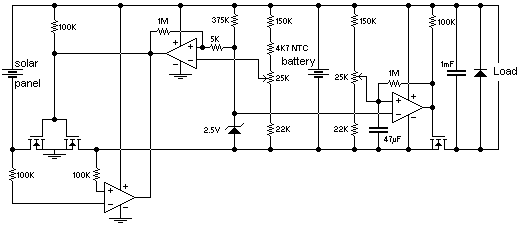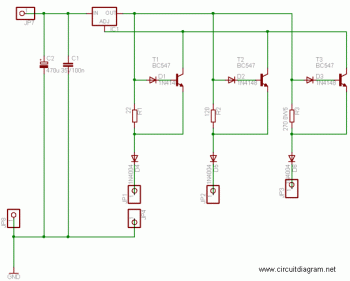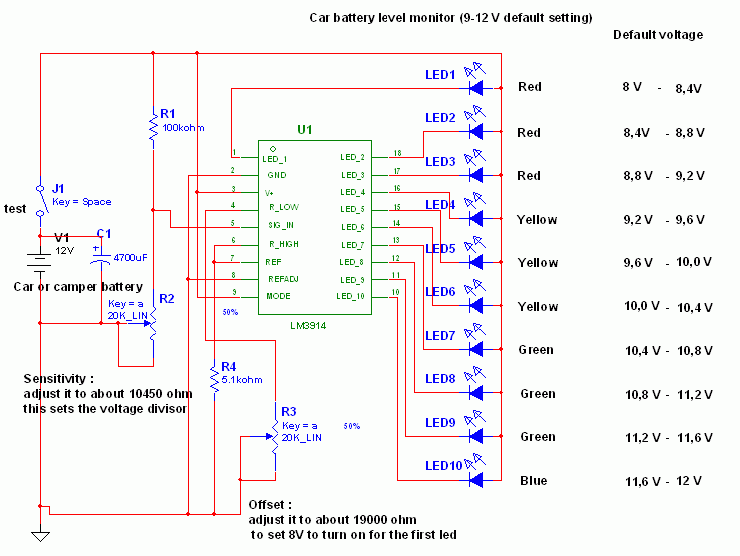
Adjustable Regulated Battery Charger

This battery charger circuit is regulated and adjustable, enabling it to charge most NiCAD batteries. It is suitable for single cells or multiple battery cells connected in series or parallel configurations. The maximum...
This battery charger circuit is designed to provide a reliable and efficient charging solution for nickel-cadmium (NiCAD) batteries. The circuit features an adjustable output voltage, allowing it to accommodate various battery configurations, whether charging a single cell or multiple cells arranged in series or parallel.
The primary components of the circuit include a voltage regulator, which maintains a consistent output voltage, and an adjustable resistor or potentiometer, which allows for fine-tuning of the charging voltage according to the specific requirements of the NiCAD batteries being charged. The circuit may also incorporate a current limiting feature to prevent overcharging, which is crucial for maintaining the longevity and performance of NiCAD batteries.
In a series connection, multiple cells are charged simultaneously, and the output voltage of the charger must match the combined voltage of the series-connected cells. Conversely, in a parallel configuration, the charger must supply sufficient current to charge each cell without exceeding the maximum current rating for any individual cell.
Safety features such as thermal protection and reverse polarity protection may also be included in the design to enhance the reliability of the charger. Thermal protection ensures that the circuit does not overheat during operation, while reverse polarity protection prevents damage to the charger and batteries in the event of incorrect connections.
Overall, this battery charger circuit is versatile and adaptable, making it suitable for various applications where NiCAD batteries are utilized, from consumer electronics to industrial equipment. Proper implementation of the circuit can lead to efficient charging cycles, improved battery life, and enhanced performance.This battery charger circuit is regulated and adjustable to make this circuit able to charge the mosto NiCAD battery. This circuit will work for single cell or multi battery cell which connected with series/parallel connection.
The maximum.. 🔗 External reference
This battery charger circuit is designed to provide a reliable and efficient charging solution for nickel-cadmium (NiCAD) batteries. The circuit features an adjustable output voltage, allowing it to accommodate various battery configurations, whether charging a single cell or multiple cells arranged in series or parallel.
The primary components of the circuit include a voltage regulator, which maintains a consistent output voltage, and an adjustable resistor or potentiometer, which allows for fine-tuning of the charging voltage according to the specific requirements of the NiCAD batteries being charged. The circuit may also incorporate a current limiting feature to prevent overcharging, which is crucial for maintaining the longevity and performance of NiCAD batteries.
In a series connection, multiple cells are charged simultaneously, and the output voltage of the charger must match the combined voltage of the series-connected cells. Conversely, in a parallel configuration, the charger must supply sufficient current to charge each cell without exceeding the maximum current rating for any individual cell.
Safety features such as thermal protection and reverse polarity protection may also be included in the design to enhance the reliability of the charger. Thermal protection ensures that the circuit does not overheat during operation, while reverse polarity protection prevents damage to the charger and batteries in the event of incorrect connections.
Overall, this battery charger circuit is versatile and adaptable, making it suitable for various applications where NiCAD batteries are utilized, from consumer electronics to industrial equipment. Proper implementation of the circuit can lead to efficient charging cycles, improved battery life, and enhanced performance.This battery charger circuit is regulated and adjustable to make this circuit able to charge the mosto NiCAD battery. This circuit will work for single cell or multi battery cell which connected with series/parallel connection.
The maximum.. 🔗 External reference





